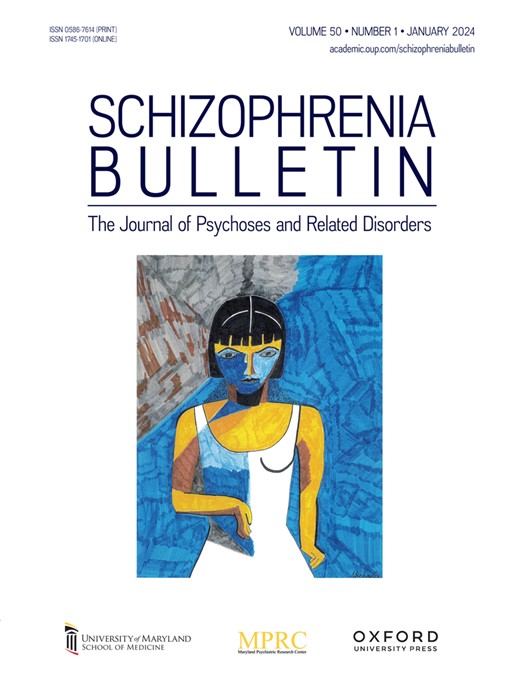Reduced Visual Function in Schizotypal Traits: An Exploratory Study
IF 5.3
1区 医学
Q1 PSYCHIATRY
引用次数: 0
Abstract
Background and Hypothesis Visual impairments have been proposed as risk factors for psychotic symptoms and illnesses. Visual impairments can considerably impact people’s daily lives, but little is known about the impact and diagnostic sensitivity of such abnormalities for schizotypal personality traits. This study aims to explore possible relationships between schizotypy and visual acuity (VA), contrast sensitivity, and parameters that describe eye movements and visual processing times. Study Design Schizotypy was assessed in 37 participants with the Multidimensional Schizotypy Scale-Brief (MSS-B). For the visual function measures, we used the Acuity-Plus test and the new Eye Movement and Integrated Saccade Latency (EMAIL) test. The latter measures oculomotor performance during an eye movement task, including the visual processing time at the end of each saccade. Study Results The disorganized dimension of the schizotypy scores predicted VA when measured with black optotypes. Additionally, we found that participants who had higher disorganized scores showed an increased response variability, as assessed through the goodness of fit measure from the EMAIL test. Conclusions These results from this exploratory study extend upon earlier findings from both general and patient samples, highlighting the clinical and subclinical importance of understanding how spatial vision can be affected in people with schizotypal disorganized behavior.分裂型特征中视觉功能降低:一项探索性研究
背景与假设视觉障碍被认为是精神病症状和疾病的危险因素。视觉障碍会严重影响人们的日常生活,但人们对这种分裂型人格特征异常的影响和诊断敏感性知之甚少。本研究旨在探讨分裂型与视觉敏锐度(VA)、对比敏感度以及描述眼球运动和视觉处理时间的参数之间的可能关系。研究设计使用多维分裂型量表(MSS-B)对37名参与者进行分裂型评估。对于视觉功能的测量,我们使用了视力测试和新的眼动和综合扫视延迟(EMAIL)测试。后者测量眼球运动任务中的眼动表现,包括每次扫视结束时的视觉处理时间。研究结果当用黑视型测量时,分裂型分数的无组织维度预测VA。此外,我们发现,通过EMAIL测试的拟合优度测量,杂乱无章得分较高的参与者表现出更高的反应变异性。这些探索性研究的结果扩展了早期的一般和患者样本的发现,强调了理解分裂型无组织行为患者的空间视觉如何受到影响的临床和亚临床重要性。
本文章由计算机程序翻译,如有差异,请以英文原文为准。
求助全文
约1分钟内获得全文
求助全文
来源期刊

Schizophrenia Bulletin
医学-精神病学
CiteScore
11.40
自引率
6.10%
发文量
163
审稿时长
4-8 weeks
期刊介绍:
Schizophrenia Bulletin seeks to review recent developments and empirically based hypotheses regarding the etiology and treatment of schizophrenia. We view the field as broad and deep, and will publish new knowledge ranging from the molecular basis to social and cultural factors. We will give new emphasis to translational reports which simultaneously highlight basic neurobiological mechanisms and clinical manifestations. Some of the Bulletin content is invited as special features or manuscripts organized as a theme by special guest editors. Most pages of the Bulletin are devoted to unsolicited manuscripts of high quality that report original data or where we can provide a special venue for a major study or workshop report. Supplement issues are sometimes provided for manuscripts reporting from a recent conference.
 求助内容:
求助内容: 应助结果提醒方式:
应助结果提醒方式:


